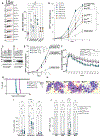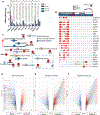Missense Mutations in Myc Box I Influence Nucleocytoplasmic Transport to Promote Leukemogenesis
- PMID: 38848040
- PMCID: PMC11326984
- DOI: 10.1158/1078-0432.CCR-24-0926
Missense Mutations in Myc Box I Influence Nucleocytoplasmic Transport to Promote Leukemogenesis
Abstract
Purpose: Somatic missense mutations in the phosphodegron domain of the MYC gene (MYC Box I or MBI) are detected in the dominant clones of a subset of patients with acute myeloid leukemia (AML), but the mechanisms by which they contribute to AML are unknown.
Experimental design: To investigate the effects of MBI MYC mutations on hematopoietic cells, we employed a multi-omic approach to systematically compare the cellular and molecular consequences of expressing oncogenic doses of wild type, threonine-58 and proline-59 mutant MYC proteins in hematopoietic cells, and we developed a knockin mouse harboring the germline MBI mutation p.T58N in the Myc gene.
Results: Both wild-type and MBI mutant MYC proteins promote self-renewal programs and expand highly selected subpopulations of progenitor cells in the bone marrow. Compared with their wild-type counterparts, mutant cells display decreased cell death and accelerated leukemogenesis in vivo, changes that are recapitulated in the transcriptomes of human AML-bearing MYC mutations. The mutant phenotypes feature decreased stability and translation of mRNAs encoding proapoptotic and immune-regulatory genes, increased translation of RNA binding proteins and nuclear export machinery, and distinct nucleocytoplasmic RNA profiles. MBI MYC mutant proteins also show a higher propensity to aggregate in perinuclear regions and cytoplasm. Like the overexpression model, heterozygous p.T58N knockin mice displayed similar changes in subcellular MYC localization, progenitor expansion, transcriptional signatures, and develop hematopoietic tumors.
Conclusions: This study uncovers that MBI MYC mutations alter RNA nucleocytoplasmic transport mechanisms to contribute to the development of hematopoietic malignancies.
©2024 American Association for Cancer Research.
Conflict of interest statement
Figures






Update of
-
Missense mutations in Myc Box I influence MYC cellular localization, mRNA partitioning and turnover to promote leukemogenesis.bioRxiv [Preprint]. 2023 Oct 23:2023.10.22.563493. doi: 10.1101/2023.10.22.563493. bioRxiv. 2023. Update in: Clin Cancer Res. 2024 Aug 15;30(16):3622-3639. doi: 10.1158/1078-0432.CCR-24-0926. PMID: 37961226 Free PMC article. Updated. Preprint.
References
MeSH terms
Substances
Grants and funding
- K08 CA252632/CA/NCI NIH HHS/United States
- K12 CA167540/CA/NCI NIH HHS/United States
- P41 GM103422/GM/NIGMS NIH HHS/United States
- R37 CA259359/CA/NCI NIH HHS/United States
- P30-CA091842/Alvin J. Siteman Cancer Center (SCC)
- P30 CA091842/CA/NCI NIH HHS/United States
- UL1 TR000448/TR/NCATS NIH HHS/United States
- P23-00364/Gabrielle's Angel Foundation for Cancer Research (GAFCR)
- 1K08CA252632-01A1/Center for Cancer Research (CCR)
- P50 CA171963/CA/NCI NIH HHS/United States
- P41 RR000954/RR/NCRR NIH HHS/United States
- P22-05508/Gilead Research Scholars (GRS)
- R01 CA227830/CA/NCI NIH HHS/United States
- R24 GM136766/GM/NIGMS NIH HHS/United States
- UL1 TR002345/TR/NCATS NIH HHS/United States
LinkOut - more resources
Full Text Sources
Medical

